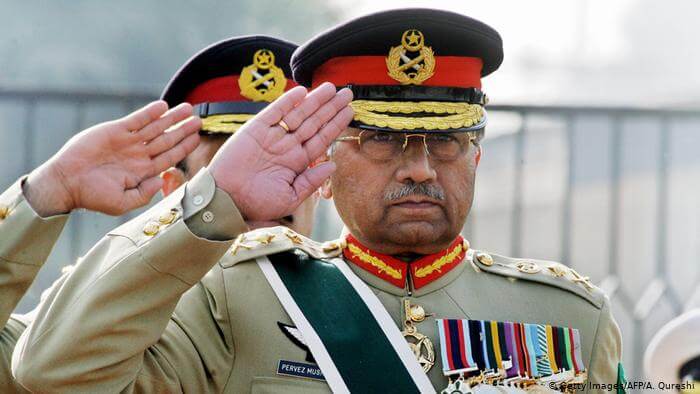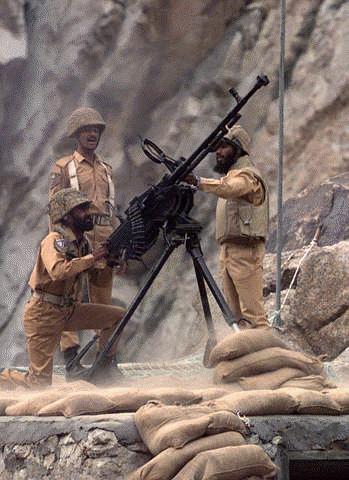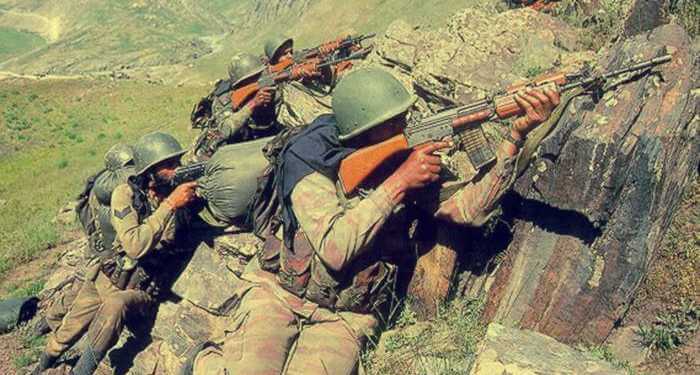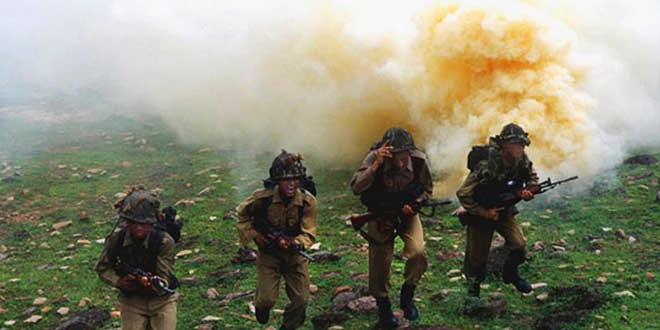The Inside Story : Mashkoh– Kargil as I saw it (Part – 2)

By
The Indian army was surprised by the Pakistani intrusions in Kargil as it never expected such large scale intrusions and that too along the heights dominating National Highway 1D. The initial reaction was that of panic and employment of troops in haste to contain the intrusions. We had never been in a situation like this. The enemy was occupying the critical heights, and we were at the base of the hills and vulnerable to his fire. These were heavily armed and dangerous men sitting on dominating heights and determined to kill anyone challenging them. Were any of us to fall into their hands, we could expect to be tortured in unspeakable ways and then decapitated for all to see. They wanted nothing less than to kill us before we dared to come near them.
Yaldor Sector
Initial reports of intrusion were reported in Yaldor sector. A villager conveyed the intrusion to 3 Punjab on 03 May 99. He informed them that some unidentified persons were seen in area Banju. On receiving information of the enemy’s presence in his area of responsibility the CO 3 Punjab sent several patrols to confirm the information in the first week of May.
The patrols spotted some 9-10 men in a black dress, identified some defensive positions comprising of sangars and bunkers with radio antenna-like projections. CO 3 Punjab sent a column and established blocks south of Banju at two places. By now, it had become clear that intrusion in the sector was at several places.

Kaksar Sector
The Winter Air Surveillance Operation (WASO) helicopter sortie also confirmed the presence of the enemy at several places. Own Bajrang post had been vacated in Mar 99 and this possibly assisted the enemy plans. 4 Jat had sent Lt Saurav Kalia in Kaksar sector to see if the route was clear to Bajrang post, which had been vacated during winter of 1998. Lt Kalia had just passed out from Indian Military Academy in Dec 1998. On 14 May he took a patrol of five men to see if the route to one of their winter vacated post was clear. When they were on their way, the patrol was fired upon by the enemy. The patrol fought back gallantly, but ran out of ammunition and was surrounded by the enemy. They were finally captured and taken prisoner of war. When 4 Jat lost radio communication with this patrol, there was panic in the battalion. Nobody knew about the whereabouts of the patrol. Captain Amit Bhardwaj of the same unit was sent with 30 men, to locate the missing patrol. They left on 17 May for their search mission. Perhaps the enemy was expecting that another patrol to come looking for Lt Kalia’s patrol party.

The enemy had laid out an ambush and was waiting for a search and rescue operation. As soon as Captain Amit Bhardwaj and his men entered the killing area, the enemy fired at them indiscriminately. Captain Bhardwaj took position along with Havildar Rajbir Singh and asked rest of the patrol to escape, while they both provided covering fire. Both these brave hearts fought bravely and ensured the rest of the patrol reached back to the battalion to tell the tale. However, in the bargain, both these brave hearts sacrificed their lives. We also heard later that the patrol of Lt Saurab Kalia of 4 Jat, which was ambushed, was tortured and killed barbarically and later the dead bodies of the soldiers were handed over to Indiaon 09 June 99. It was observed that the bodies of these brave men of 4 Jat were found mutilated with deep wounds and eyes gouged out.
Dras Sector
Meanwhile, information started trickling in from locals about Pakistani intrusion in the Dras sector also. Several patrols sighted move of persons in black dress and carrying loads at several places. Own helicopters carrying out recce were fired at some locations. Own patrols also encountered fire from enemy positions.
Mashkoh Sector
Only two companies of Rashtriya Rifles were deployed in Mashkoh area. Hence owing to the scarcity of troops and large gaps in the area, the intrusions in Mashkoh were detected at a much later stage, once 79 Mountain Brigade was inducted on 25 May 99. It was becoming crystal clear that the enemy’s presence within the 121(I) Infantry Brigade sector was indeed much more robust and more widely deployed than it was estimated. The penalties of intelligence failure, at all levels, were coming home to roost.

The deployment of the enemy remained unknown in the initial stages. It was only after own forces started probing the area of intrusion and subsequently decided to surround them or evict them, the enemy layout emerged. Each time this happened, it not only came as a surprise, but own troops suffered casualties as well. This gradual emergence of enemy disposition continued into the late stage of ‘Operation Vijay’. With the detection of intrusion in Yaldor, Kaksar and Dras sectors, the task at hand was to contain and then evict the intruders. There was limited reaction capability available with 3 Infantry Division, to deal with the enemy intrusions once they were detected. Only 70 Infantry Brigade was available for the task. Even this formation was not in full strength owing to various commitments. It had two battalions with 50% strength available.
The forces available and their employment in the initial stages was as follows:
- Headquarter 70 Infantry Brigade moved from valley to Batalik on 10 May.
- 56 Mountain Brigade was inducted at Dras on 17 May.
- 79 Mountain Brigade was inducted on 25 May.
- The employment of Air Force was initiated, and the first airstrikes were launched on 26 May. The air effort received a setback when two aircraft were engaging Muntho Dhalo from the direction of Chorbat La were knocked down on 27 May. The next day one MI-17 was brought down by enemy stinger missile. It put a damper on the employment of air since the Air Force engaged in a rethink on tactics and weapon delivery methods.
- Headquarter 8 Mountain Division moved in and took over the responsibility of Dras and Mashkoh sectors on 01 June 99.
Initial Attack on Tiger Hill
8 Sikh had just arrived on 09 May from Pathankot to Pulwama and were settling down in the new environment. However only three days later (12 May) they received the warning order for a move to Dras and moved off from their location on 14 May and reported to the commander 121(I) Infantry Brigade, for operational duties. Next day, they were launched into operations without appropriate clothing and equipment and with no time for troops to be acclimatized, for the capture of Tiger Hill. No time for preparation and rehearsals were given. There was no information available about the adversary’s strength on the feature other than the legendary briefing by the brigade commander- “There are few mujahidin on the top, go and throw them off”. 121(I) Infantry Brigade was in a state of puzzled confusion about the points of infiltration by the enemy. 8 Sikh was rushed into offensive operations in a high-altitude area without any orientation training for the attack in high altitude area, for the capture of Tiger Hill. But since the enemy was entrenched in strength along the entire ridge, 8 Sikh could not make any meaningful progress. However, the battalion stubbornly held their positions 800 meters short of the objective. 8 Sikh suffered a lot of casualties due to lack of proper clothing and acclimatization of troops.

Initial Attack on Tololing
18 Grenadiers was part of 56 Mountain Brigade on counter-insurgency grid in Ganderbal area. They reached Dras on 20 May. On 22 May 56 Mountain Brigade also moved to Dras sector and took over the responsibility from 121(I) Infantry Brigade. Similarly, on 23 May,18 Grenadiers and 1 Naga were also ordered to capture Tololing and Point 5140respectively without much information about the enemy except that 8-10 mujahidin may hold it. They also were employed in haste without any acclimatization and orientation training towards offensive operations in high altitude area. Both the battalions came under intense enemy fire and were pinned down on the lower slopes of the hill without making any substantial progress. Leading elements of the unit were held up approximately 800 meters from the objective. The brigade commander 56 Mountain Brigade, again committed his troops without giving them adequate time to prepare for this specialized operation and lack of sufficient information about the enemy. Both the battalions suffered avoidable casualties due to lack of proper acclimatization and training.
Let us analyse the reason for the failure of the initial operations. Firstly, acclimatization was a mandatory requirement before launching the troops into battle. These troops were operating at 6000-7000 feet in the valley. I Naga,8 Sikh and 18 Grenadiers was tasked for operations without acclimatization due to which they suffered many high-altitude related sicknesses and thus reduced their battle worthiness. Secondly, preparedness, which includes rehearsals, preparation, training and proper equipment for the operations was missing. They were inducted into conventional offensive operations in high altitude terrain form their role of counter-insurgency without any orientation training to adapt to the new environment. Thirdly, accurate information about the enemy is an essential factor and units being launched into battle must have a sound assessment of the enemy. Regrettably, we did not have required degree of intelligence necessary for the operations. While we generally knew the location of the enemy, but we had no idea about his deployment. Patrols sent in the initial stages failed to get any valuable information due to initial fear of coming in contact with the enemy. Due to the reasons above, the unit and sub-unit commanders involved in the operations did not believe in the success of the mission. If the junior leaders didn’t believe in the success of the mission, they could in no way convince the soldiers to believe in it. As a result, they would never commit to it, and it would fail. To convince and inspire others to follow and accomplish a mission, a leader must be a true believer in the success of the mission.

We were trying to occupy the unheld areas/ lightly held parts. The ingress into the sector was estimated to be four km deep and five km wide. It was no ordinary intrusion but a deliberate ingress to hold ground both in tactical and logistic terms and consolidate their intrusion permanently. It was clear that Pakistani regular troops were involved at a directional and functional level.
It was evident that given the extreme nature of the terrain, elimination of intrusion would require much greater effort than the present force level could exert. 8 Mountain Division presently on counter-insurgency grid in Srinagar valley was placed on short notice to move to Kargil sector to take over part responsibility from 3 Infantry Division. Dras and Mashkoh sub-sector were placed under 8 Mountain Division (from 01 June) with Dras sub-sector under 56 Mountain Brigade (from 22 May) and Mashkoh sub-sector under 79 Mountain Brigade (from 24 May). Brigadier Amar Aul was commander 56 Mountain Brigade and Brigadier RK Kakkar was commander 79 Mountain Brigade. 56 Mountain Brigade was part of 8 Mountain Division, while 79 Mountain Brigade was 15 Corps reserve formation.
The Mashkoh warriors were inducted into the sector to stabilise the situation on 26 May 1999. To know more, read the book Mashkoh: Kargil as I saw it.




